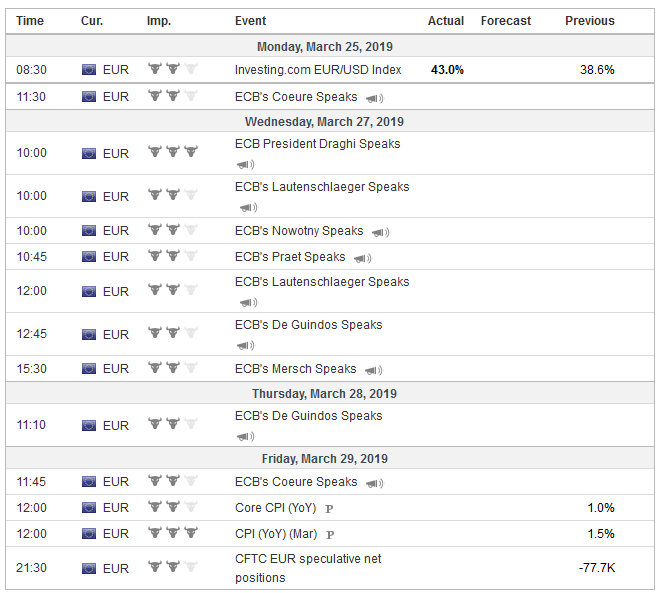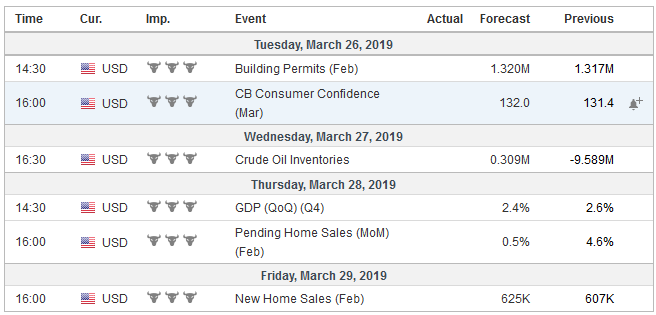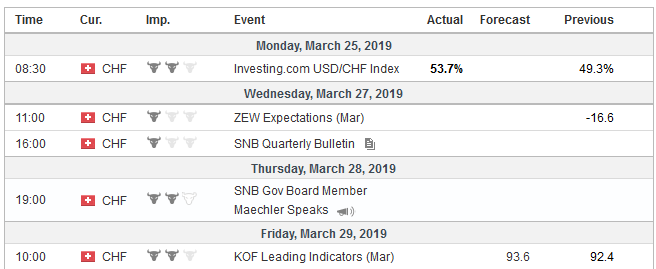The combination of the dovish hold by the Federal Reserve and the eurozone’s miserable flash Purchasing Managers Index casts a pall over the economic outlook. Japan’s flash PMI remained stuck at February’s 48.9, while core inflation unexpectedly eased. Three months after the European Central Bank stopped buying bonds, the German 10-year Bund yield fell below zero for the first time since 2016. Japan’s 10-year yield is near minus eight basis points, the most since 2016 as well. The US 10-year fell to 2.44%, the lows since early last year. Going into the last week of March, the US 10-year yield has fallen about 22 bp in Q1. German, French, Italian and Spanish yields have fallen 25-35 basis. Portuguese and Australian
Topics:
Marc Chandler considers the following as important: 4) FX Trends, Brexit, China, ECB, Featured, FOMC, Interest rates, newsletter
This could be interesting, too:
Nachrichten Ticker - www.finanzen.ch writes Die Performance der Kryptowährungen in KW 9: Das hat sich bei Bitcoin, Ether & Co. getan
Nachrichten Ticker - www.finanzen.ch writes Wer verbirgt sich hinter der Ethereum-Technologie?
Martin Hartmann writes Eine Analyse nach den Lehren von Milton Friedman
Marc Chandler writes March 2025 Monthly
The combination of the dovish hold by the Federal Reserve and the eurozone’s miserable flash Purchasing Managers Index casts a pall over the economic outlook. Japan’s flash PMI remained stuck at February’s 48.9, while core inflation unexpectedly eased. Three months after the European Central Bank stopped buying bonds, the German 10-year Bund yield fell below zero for the first time since 2016. Japan’s 10-year yield is near minus eight basis points, the most since 2016 as well. The US 10-year fell to 2.44%, the lows since early last year.
Going into the last week of March, the US 10-year yield has fallen about 22 bp in Q1. German, French, Italian and Spanish yields have fallen 25-35 basis. Portuguese and Australian bond yields have fallen around 45 bp and 48 bp respectively.
EurozoneThe sharp decline in interest rates is a significant development. The precipitating cause of the decline in rates has been disappointing data and signals from officials. ECB Draghi explained that not only had the staff slash this year’s growth forecast to 1.1% from 1.7% at the end of last year but that the risks were still skewed to the downside. In explaining the unanimous decision to offer new long-term loans to banks, he noted that everyone was in the same boat. That seemed to be a reference to the fact that after contracting in Q3, the German economy barely avoided a second quarterly contraction. Italy was not as lucky. Draghi’s might have well anticipated the flash PMI. The manufacturing slump deepened. The aggregate PMI fell to 47.6 from 49.3. Many, including ourselves, had expected some improvement. The new order component is as far below the 50 boom/bust level as it has been in years. In Germany, Europe’s locomotive, news orders slumped to 40.1, the lowest level in a decade. The French manufacturing sector had been faring better than Germany’s, perhaps as a result, ironically, because its industries are less competitive and less reliant on exports to China, but it too succumbed to the drag. Its flash March PMI dropped to 49.8 from 51.5, and new orders fell even further to 47.8. Compounding the disappointment, the service PMI tumbled to 48.7 from 51.2. With those inputs, the composite fell 48.7. |
Economic Events: Eurozone, Week March 25 |
One of our interpretative points has been that the most pressing problems for the EMU does not emanate from the periphery, despite the volumes of columns highlighting Italy’s bad loan problem or fractious governing coalition, but from the core. France’s political and economic weakness for several years throws the delicate European balance off kilter, saved to no small extent by the ECB. That Italy’s economy is weak is a dog-bites-man story. That the Germany economy is struggling now, that is news. Moreover, the flash PMI implied better periphery readings, which will be available at the start of next month.
Progress in reducing Italy’s bad bank burden has accelerated, and the work goes on. We argue this is a chronic situation in Italy. Germany’s seems acute. Recall that during the crisis, it acted relatively quickly (kudos for that) but then helped change the rules to make it harder to do what it did. Apparently, judging in part as a shareholder of Deutsche, the challenges of the German banking system were not addressed. Given the size of its balance sheet, a multiple of German GDP, Deutsche changes the question from too-big-to-fail to too-big-to-save.
Now, the government is encouraging a combination of Deutsche and Commerzbank. Cost savings of the combine, the main selling point, comes from slashing employment (estimates are 20-30k job cuts), which is why the union reps on both boards are opposed. The Social Democrat finance minister supports the combine as if moving more away from labor issues will boost its standing in the polls, where it is in danger of slipping into third place behind Merkel’s CDU and the Greens.
The Italian coalition seems to prove the adage that politics makes for strange bedfellows. But while the fingers were being pointed to Italy, it is the center-right Dutch government that lost its Senate majority and the populist-right Forum for Democracy has as many seats as Prime Minister Rutte’s party. It enjoys momentum ahead of the May EU Parliament election. The weekend “Yellow Vest” protests continue in France, and the government has escalated its attempt to counter them by drawing in the military, not just the police, and using high-speed rubber bullets (LBD guns) that the Council of Europe and the United Nations want banned.
United StatesEconomists from large debtor countries often harangue Germany to loosen fiscal policy as it commits itself to fulfill its obligations under the Stability and Growth Pact to reduce its debt/GDP to 60%. And, in any event, its Ordoliberalism disagrees with the Keynesian use of fiscal policy for cyclical stimulus. At the same time, reports that the government is considering a cut in defense spending projections no doubt have caught the attention of the US Administration. It is unlikely to be a good sign for future trade talks. The US continues to threaten 25% tariff on auto imports, on national security grounds, as it has implemented the steel and aluminum tariffs. Europe, where the Common Agriculture Program, accounts for a little more than a third of the EU’s budget, does not want to discuss agriculture, which the US is demanding. Another interpretative point puts emphasis on the divergence on that the US and Europe are taking different stances toward China. The Trump Administration is interested in securing a US sphere of influence, which in the 21st century means market share. Reports indicate that it purposely wants to block others from gaining from the US deal, including a clause in the new NAFTA that allows the US to leave it if the others enter a free-trade agreement with a non-market economy (i.e., China). The focus is on the US-China trade talks, where Lighthizer and Mnuchin are in Beijing and Liu will come to the US the following week. After sending signals that negotiations may take the entire second quarter as well, President Trump played up that the sides are getting close. Meanwhile, President Xi spent last week in Italy and will spend the week ahead in France. This is ahead of the EU-China summit in on April 9. |
Economic Events: United States, Week March 25 |
Europe is trying to find a middle ground between the US and China, which presupposes a prior divergence of interests. Europe resisted US efforts to show a united front not to participate in China’s Asia Infrastructure Investment Bank. Italy seems to be flirting with China’s One-Belt One-Road Initiative. Several countries, including the UK and Germany, have been reluctant to ban Huawei as the US has demanded or risk being denied access to some of its intelligence.
Many investors act as they heard the Fed adopt an easing bias and have gone a long way toward pricing in a cut at the end of the year. Powell, specifically there was no bias of the next direction, though the median forecast has the next move higher, but not until next year, which is a subtle way to play down the dot plot. Powell told investors that statement not the forecasts are where the Fed expresses its intent. We see the statement less dovish than the forecasts and note that even the average did not fall as much as the median for this year’s rate outlook (35 bp. vs. 50 bp).
The Fed’s patient stance means that the likely downward revision of Q4 GDP to 2.4% from 2.6% has not policy significance. The external sector looks to have been a bigger drag. The problems at Boeing can be expected to show up in some high-frequency macro data, like exports (down) and inventories (up) in the first instance, but production moderation may follow.
The January PCE deflator will command attention because due to the base effect, the year-over-year rate is likely to slow to 1.4% from 1.7%. This is important because this is the measure of inflation the Fed targets. The core rate, which sometimes the rhetoric emphasizes, and excludes food and energy, will likely be stickier just below 2.0%.
Of note, the eurozone reports its first estimate of March CPI, and it is expected to be unchanged at 1.0% at the core level and 1.5% at the headline level. It is a timely reminder that measures of CPI vary. ECB’s has developed a uniform measure of consumer inflation (HICP) that makes international comparisons meaningful. A key difference is the component for shelter, where Europe sees ownership as an investment decision not a question of consumption. If the US were to adopt this methodology, US CPI would be at eurozone levels.
Japan’s economy is struggling to maintain forward momentum. The economy contracted in Q3 18 and rebounded in Q4, but the risk is that it contracted in the first part of 2019. However, the January data likely overstated the case. Then industrial output fell 3.4% in the month but is expected to have bounced back 1.3% in February. The same pattern should be evident in February retail sales, which are forecast to have risen 0.8% in February falling a revised 1.8% in January.
March 29 was to be the day the UK left the EU, but the day will pass with little fanfare. The UK appeared to fumble the ball. May made an untenable offer to the EC, and they were forced to take greater control of the situation. It said the UK will not leave the EU with an agreement now. It was given a free pass until April 12, which is the last day that the UK participate in the EU elections at the end of May.
By asking for a three-month delay May showed no regard for the EU elections, which seemed to underscore the arguably tone-deaf approach. When pressed by other heads-of-state, May reportedly could not answer what she was going to do to pass the Withdrawal Agreement. Even if the Speaker accepts that the assurances offered by the EC change the bill sufficient to hold a new vote, it does not appear likely to pass. The initial response by the DUP suggests positions have hardened.
If this is indeed the case, then the most likely scenario it seems is a longer delay. It is difficult to see how May survives, but she has defied the odds before. A one-two year delay would likely be seen as positive for sterling on ideas that monetary policy can come back into the fore.
Switzerland |
Economic Events: Switzerland, Week March 25 |
Tags: Brexit,China,ECB,Featured,FOMC,Interest rates,newsletter



